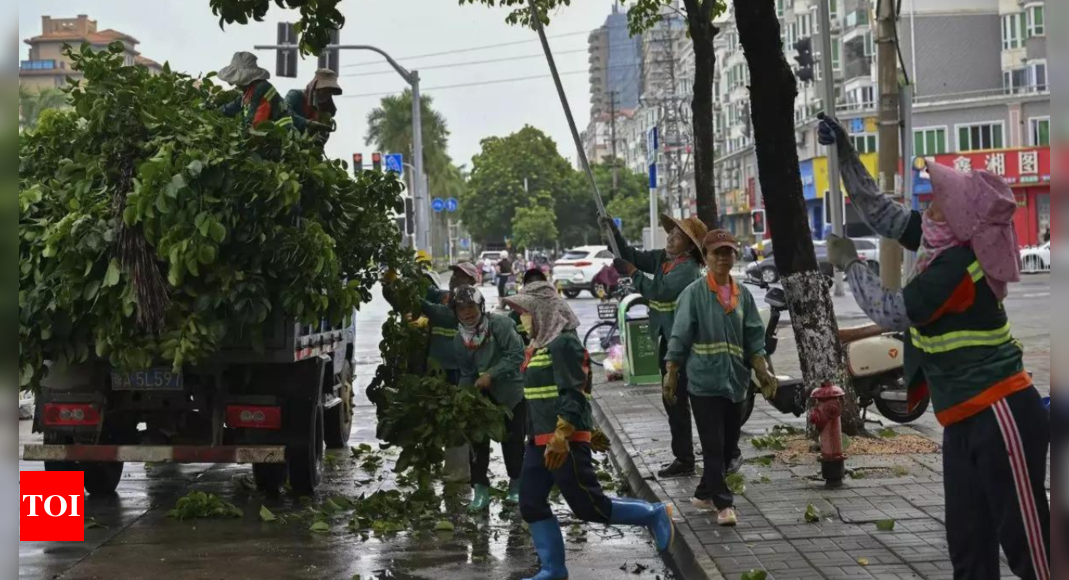
China is preparing for super typhoon Yagi, one of its strongest storms in a decade, expected to make landfall on Friday afternoon (local time). The storm is expected to bring severe winds, torrential rains, and coastal flooding to the southern provinces of Guangdong and Hainan.
Chinese authorities have intensified emergency measures, closing schools and offices in multiple cities and evacuating more than 410,000 residents in Hainan.Boats have been secured, and flights, ferries, and trains have been canceled.
By Friday afternoon, the worst of the storm had already passed south of Hong Kong, prompting the Hong Kong Observatory to lower its alert level from the third-highest typhoon signal, Level 8, to Level 3 at 12:40 p.m. Although the storm, which had rapidly intensified from late Wednesday into Thursday, had slightly weakened, it remained powerful.
Yagi, also known as Enteng, is expected to make landfall near the Qiongzhou Strait, the waterway between Hainan Island and the Leizhou Peninsula of Guangdong province. After moving through Guangdong and Hainan, the storm is expected to reach Vietnam as a weaker typhoon or tropical storm.
Typhoon warning issued in Shenzhen
Shenzhen’s meteorological bureau issued a typhoon warning, stating, “The state of typhoon defense is triggered.” “Emergency shelters shall be open. Residents should stay in safe places for temporary shelter. Employers should adopt flexible arrangements such as postponing, leaving earlier, or suspending operations. Relevant emergency response departments and rescue units should be well-prepared.”
Hainan official warns of catastrophic damage
Hainan’s authorities, including Li Xun, director of the Hainan Meteorological Observatory, have warned of potential catastrophic damage, urging preparations for large-scale evacuations. “Yagi could cause catastrophic damage to the northeastern coastal areas of Hainan upon landfall, and preparations for large-scale evacuation of people near the landfall point must be made,” Li said.
The region is familiar with severe typhoons, such as Typhoon Rammasun in July 2014, which caused significant damage and fatalities with winds reaching 145 mph.
Fishing boats seek refuge
In Guangdong, over 80,000 fishing boats have sought refuge as local officials ordered all vessels back to port. Public events have been canceled, and people have been advised to stay indoors.
Hainan’s transport services, including the airport and high-speed rail, have ceased operations.
Most intense storm in 55 years
Yagi reached its peak strength on Thursday morning with winds of 155 mph, just shy of Category 5 status, and dropped to an air pressure of 915 millibars, making it the most intense storm in the South China Sea in 55 years. It is the second-strongest storm globally in 2024, behind Hurricane Beryl in the eastern Caribbean, which had winds of 165 mph.
Till Thursday afternoon, Yagi regained some strength, with maximum sustained winds expected to be between 115 and 130 mph upon making landfall, qualifying it as a Category 3-equivalent storm.
Potential impacts of Yagi
With an increasing chance of Yagi’s westerly drift, the storm could bring severe impacts to Haikou, Hainan’s provincial capital with 3 million residents. Haikou may fall within the storm’s western eyewall, the zone of maximum winds and heavy rain surrounding the typhoon’s eye.
There is also a possibility of a storm surge, especially in northern Yagi’s center, potentially raising seawater levels by more than six feet in southern Xuwen County. The Qiongzhou Strait might experience additional surge impacts affecting Haikou based on Yagi’s path.
Severe weather, a growing concern in China
Severe weather in China has been increasing due to climate change. Regions in the northwestern and southern provinces have recently battled severe flooding and record-breaking heatwaves, highlighting the nation’s vulnerability. For example, Qinghai province saw its highest rainfall since 1954, and a heatwave along the Yangtze River led to the postponement of the school year due to extreme temperatures.
14 dead due to storm in Philippines
Earlier this week, Yagi caused 14 fatalities in the Philippines.
Chinese authorities have intensified emergency measures, closing schools and offices in multiple cities and evacuating more than 410,000 residents in Hainan.Boats have been secured, and flights, ferries, and trains have been canceled.
By Friday afternoon, the worst of the storm had already passed south of Hong Kong, prompting the Hong Kong Observatory to lower its alert level from the third-highest typhoon signal, Level 8, to Level 3 at 12:40 p.m. Although the storm, which had rapidly intensified from late Wednesday into Thursday, had slightly weakened, it remained powerful.
Yagi, also known as Enteng, is expected to make landfall near the Qiongzhou Strait, the waterway between Hainan Island and the Leizhou Peninsula of Guangdong province. After moving through Guangdong and Hainan, the storm is expected to reach Vietnam as a weaker typhoon or tropical storm.
Typhoon warning issued in Shenzhen
Shenzhen’s meteorological bureau issued a typhoon warning, stating, “The state of typhoon defense is triggered.” “Emergency shelters shall be open. Residents should stay in safe places for temporary shelter. Employers should adopt flexible arrangements such as postponing, leaving earlier, or suspending operations. Relevant emergency response departments and rescue units should be well-prepared.”
Hainan official warns of catastrophic damage
Hainan’s authorities, including Li Xun, director of the Hainan Meteorological Observatory, have warned of potential catastrophic damage, urging preparations for large-scale evacuations. “Yagi could cause catastrophic damage to the northeastern coastal areas of Hainan upon landfall, and preparations for large-scale evacuation of people near the landfall point must be made,” Li said.
The region is familiar with severe typhoons, such as Typhoon Rammasun in July 2014, which caused significant damage and fatalities with winds reaching 145 mph.
Fishing boats seek refuge
In Guangdong, over 80,000 fishing boats have sought refuge as local officials ordered all vessels back to port. Public events have been canceled, and people have been advised to stay indoors.
Hainan’s transport services, including the airport and high-speed rail, have ceased operations.
Most intense storm in 55 years
Yagi reached its peak strength on Thursday morning with winds of 155 mph, just shy of Category 5 status, and dropped to an air pressure of 915 millibars, making it the most intense storm in the South China Sea in 55 years. It is the second-strongest storm globally in 2024, behind Hurricane Beryl in the eastern Caribbean, which had winds of 165 mph.
Till Thursday afternoon, Yagi regained some strength, with maximum sustained winds expected to be between 115 and 130 mph upon making landfall, qualifying it as a Category 3-equivalent storm.
Potential impacts of Yagi
With an increasing chance of Yagi’s westerly drift, the storm could bring severe impacts to Haikou, Hainan’s provincial capital with 3 million residents. Haikou may fall within the storm’s western eyewall, the zone of maximum winds and heavy rain surrounding the typhoon’s eye.
There is also a possibility of a storm surge, especially in northern Yagi’s center, potentially raising seawater levels by more than six feet in southern Xuwen County. The Qiongzhou Strait might experience additional surge impacts affecting Haikou based on Yagi’s path.
Severe weather, a growing concern in China
Severe weather in China has been increasing due to climate change. Regions in the northwestern and southern provinces have recently battled severe flooding and record-breaking heatwaves, highlighting the nation’s vulnerability. For example, Qinghai province saw its highest rainfall since 1954, and a heatwave along the Yangtze River led to the postponement of the school year due to extreme temperatures.
14 dead due to storm in Philippines
Earlier this week, Yagi caused 14 fatalities in the Philippines.









